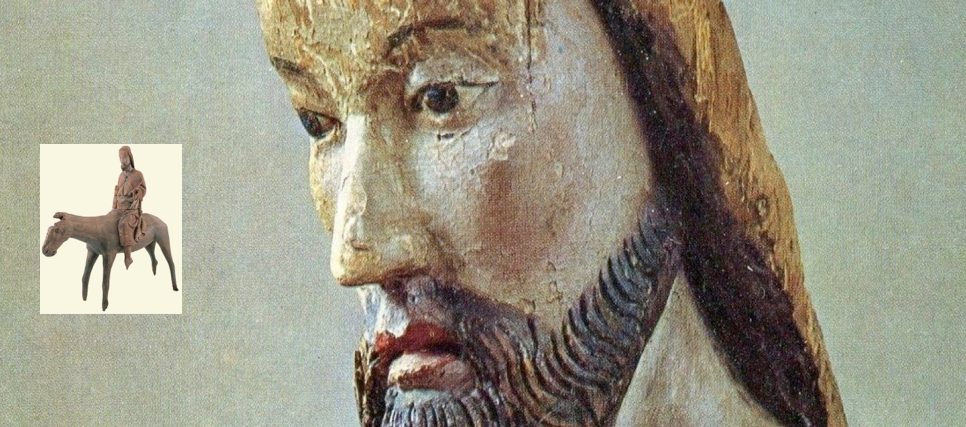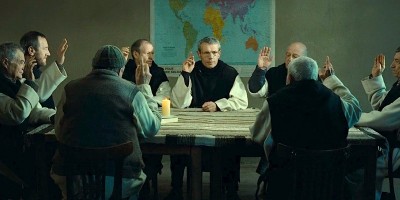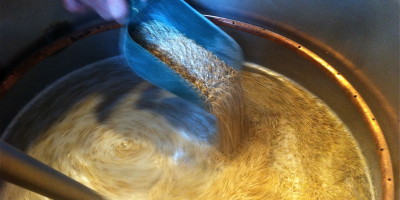Henri Nouwen once spent an afternoon in the Augustiner Museum in Freiburg, meditating on a fourteenth-century wooden sculpture of Christus auf Palmesel (Christ on palm-donkey). It was, he wrote, one of the most moving Christ figures he knew.
Made to be pulled on a cart in the Palm Sunday procession, the sculpture came originally from Niederrotweil, a small town close to the Rhine close to Freiburg. Christ’s long, slender face with a high forehead, inward-looking eyes, long hair and a forked beard held Nouwen spellbound with the mystery of his suffering.
“As he rides into Jerusalem surrounded by people shouting ‘hosanna’,” wrote Nouwen in The Road to Daybreak, “Jesus appears completely concentrated on something else. He does not look at the excited crowd. He does not wave. He sees beyond all the noise and movements to what is ahead of him: an agonizing journey of betrayal, torture, crucifixion, and death. His unfocused eyes see what nobody around him can see; his high forehead reflects a knowledge of things to come far beyond anyone’s understanding.”
Nouwen saw both melancholy and peaceful acceptance in this facial expression; insight into human fickleness but also immense compassion; deep awareness of unspeakable pain to be suffered, but also a strong determination to do God’s will. He saw in the Christ-figure an endless, deep and far-reaching love born from intimacy with God, reaching out to all. He was reminded that Christ saw him with all his sins, guilt, and shame and loved him with all his forgiveness, mercy and compassion.
“Just being with him in the Augustiner Museum is a prayer,” he wrote. “I look and look and look, and I know that he sees the depths of my heart; I do not have to be afraid.”
Dire warning
And yet remarkably, when we read the chapters in Matthew (21-25) describing the last week before the Crucifixion, Jesus does not seem preoccupied with his suffering to come–until chapter 26, two days before the passover. Something else also seems to have preoccupied his thoughts as the crowds cheered him into the ancient city.
Look at his actions and his parables: the cleansing of the temple, the cursing of the fig-tree, the parable of the two sons, the parable of the vineyard tenants, followed by the parable of the wedding feast (chapters 21 & 22). None of these focus on his forthcoming death. Read the seven woes spoken over the pharisees whom he calls serpents and brood of vipers. And the dire warning of the house becoming desolate: Jerusalem and the temple will be destroyed, Jesus clarifies in the next chapter to his incredulous disciples.
So far, he has made only one veiled reference to his forthcoming death – the story of the vineyards tenants who killed the son of the owner. Instead he talks of his longing to gather the children of Jerusalem, but they were not willing. Although prior to his arrival in Jerusalem he has on three occasions (16:21, 17:22, 20:17) already talked to the disciples about his approaching suffering and death, no specific mention of it is made again until just hours before his Passion.
Connecting thread
So what is on his mind? What is the connecting thread through these stories and actions? Was his heart not also burdened with the fate of Israel and of the Jews who had not recognised the day of their visitation? The cleansing of the temple–a house of prayer for all peoples turned into a commercial market-place–represented judgement on a people who had forgotten why they had been chosen: as a light to the gentiles. The fig tree was cursed for being fruitless. Who was the son who agreed to do the father’s will, but didn’t? and the other who initially refused but ended up obeying? The wedding feast tells of the invited guests (Jews) who were too busy to come; the outcasts (read Gentiles) were then invited in.
For me, the key passage is the story of the wicked tenants (21:33-46), who kill the owner’s messengers and then his own son, thinking they would stand to inherit the property themselves. Jesus asks the crowd to judge: “What will the owner do to those tenants?” They all know the right answer: “He will bring those wretches to a wretched end and lease the vineyard to other tenants who will give the owner his produce.”
“Exactly!” Jesus in effect replies. He then adds: “(Therefore) the Kingdom of God will be taken from you and given to a people who will produce its fruit.” Surely that has to be one of the saddest verses in the New Testament! While Paul gives us reason for hope concerning Israel and the Jews (Romans 9-11), Jesus actually doesn’t.
Can we not also read the tragic implications of Israel’s rejection of their Messiah in the face of that wooden Christ figure?
Till next week,




This is wonderful! Perfect for today Palm Sunday, 2024. I came to your site via the daily deco from Henri Nouwen daily devo, arriving today Sunday Mar 24.
Thank you!
Thank you… simply that…
I’ve been blessed by your reflection today. Thank you!
I, too, found your site in searching for “Christ on Palm-Donkey” after reading today’s Lenten reading in “Show Me the Way.” His eyes! As Nouwen said…”not looking at the crowd…He sees beyond all the noise and movement to what is ahead of him…His unfocused eyes see what nobody around him can see.” Thank you
Thank you! A friend shared with me on Palm Sunday 2025 inspired by Nouwen’s Lenten reflection book.